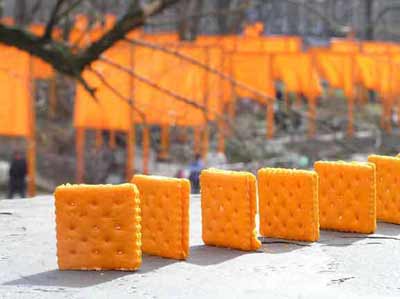Category Archives: Central Park
Saturday, March 19th, 2005
|
|
|
Patti Smith on stage in Central Park for the Troops Out Now rally.
|
|
|
|
Respectable suburban houswives against war.
|
|
|
|
The Missile Dick Chicks.
|
|
|
|
Cheney and oil guzzling Bush puppet.
|
|
|
|
97 years old and outraged!
|
|
|
|
Veteran for Peace.
|
| More photos including some panoramas of the crowd |
Anti War Rally Saturday NOON - Central Park, East Meadow 97th St. and 5th Ave. Be There! Listen to WBAI 99.5 FM for live coverage.
Saturday, March 12th, 2005
|

|
| “Cleopatra’s Needle” The obelisk now in Central Park on Greywacke Knoll behind the Metropolitan Museum of Art, started out in the Aswan Quarry around 1475 B.C. (Photo of an unfinished obelisk there.) All the quarrying, carving and polishing was done there, and the finished product—69 feet 6 inches high and weighing 224 tons—was barged down the Nile 600 miles, and then via canal to Heliopolis and erected. (Map of Egypt) It was one of a pair of red granite obelisks for the Temple of Tum. The obelisk was sheathed in electrum —a gold/silver alloy. |
It stood for 1000 years until it was toppled by the Persian conqueror Cambyses. It lay on the ground for five centuries, until 13 B.C. when Caesar Augustus, wanted it for the waterfront entrance of his Caesarium—a great temple in Alexandria erected to commemorate the Roman conquest of Egypt. As it was placed before the very structure where Cleopatra and Antony were lovers, it became known as “Cleopatra’s” obelisk, though she was dead ten years prior to its erection.
The base of the monument was broken and Pontius, the Roman architect in charge, cast great bronze crabs with dowels fitting into both the pedestal and the obelisk to support it. The crab is associated in Roman mythology with the worship of Apollo and the sun—and by extension the divinity of the Pharaohs—they were acceptable to the Egyptians.
|

|
| Replicas of the four original bronze crabs cast in the Brooklyn Navy Yard. Two of the originals are on display in the Met. |
|
Shortly after the Suez Canal opened in 1869, the Khedive of Egypt, Ismail Pasha, had a conversation with William Henry Hurlbert, editor of the New York World. The Khedive was keen to sell Egyptian cotton to the West. “A great way to open the harbor and the hearts of New York would be for Your Highness to present America with an Egyptian obelisk. After all, both London and Paris have been so honored.” The Khedive agreed.Lieut. Commander Henry Honeychurch Gorringe an acquaintance of William H. Vanderbilt, who financed the project, won the engineering contract, negotiated the financing and overcame the obstacles to bring the obelisk to Central Park.
Photos:
Sheathed in wood and pivoting pivoting on a structure, Alexandria
In Alexandria prior to shipping.
Coming ashore from the Hudson River at 96th Street.
The obelisk in Central Park in 1881. Compare how sharp the lower hieroglyphs are to my photo above.
It took 112 days to roll the obelisk from the river to the site. The obelisk was placed with the same orientation to the sun, as in Alexandria. Gorringe also arranged to leave a space between the foundation stones to serve as a time capsule into which he placed lead boxes containing documents, records, obelisk data, coins and medals, the Bible, the works of Shakespeare, a dictionary and samples of various tools in common use.
More great photos, links and discussion on Design Observer
Most of the above story was excerpted from “An Obelisk for Central Park - “Forgive the pun, Your Highness, but any old obelisk will do.” - by Edmund S. Whitman.
My photo was taken on the opening day of “The Gates.” It is a three photo mosaic. Notice the helicopter in the top left of the photo, one of two that were constantly, noisily, hovering over the event. |











